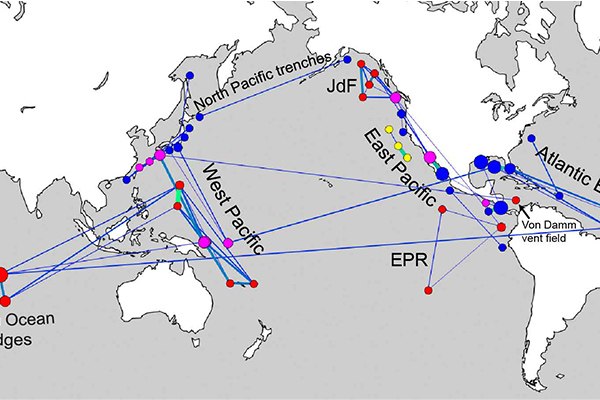Deep-Sea Ecosystems: Biogeography of Methane-Seep Faunas Through Time

Summary
Life in the deep-sea has fascinated both scientists and the public for centuries, yet many evolutionary and biogeographic questions remain controversial. The biogeography of the deep-sea today has a historical basis for which the fossil record provides the most direct evidence.
With this project I aim to provide the first survey and analysis of the biogeographic evolution of deep-sea metazoans through the last 50 million years of Earth’s history on a global scale. The deep-sea methane-seep fauna provides an excellent model system for this purpose:
- It consists of characteristic taxa that can readily be identified;
- These characteristic taxa are restricted to the deep sea and this restriction is known from the geologic past and even among now extinct taxa;
- Seep faunas have a much higher fossilization potential than ‘ordinary’ deep-sea taxa due to the in situ carbonate precipitation at methane seeps.
Based on new material from three key areas and using novel analytical approaches, I will focus on four main questions:
- Was the Pacific Ocean the center of origin?
- Was the Atlantic Ocean colonized through the Isthmus of Panama?
- Which role did the former Tethys Ocean have in faunal dispersal?
- What were the effects of the Messinian salinity crisis?
This research is funded by the Swedish Research Council (VR)
Project Participants at the Museum
External Project Participants
CNR-ISMAR, Bologna, Italy
Selected Publications
Kiel, S., Birgel, D., Lu, Y., Wienholz, D., and Peckmann, J. 2021. A thyasirid-dominated methane-seep deposit from Montañita, southwestern Ecuador, from the Oligocene-Miocene boundary. Palaeogeography, Palaeoclimatology, Palaeoecology 575: 110477.
Kiel, S., Hybertsen, F., Hyžný, M., and Klompmaker, A.A. 2020. Mollusks and a crustacean from early Oligocene methane-seep deposits in the Talara Basin, northern Peru. Acta Palaeontologica Polonica 65: 109-138.
Kiel, S., Aguilar, Y.M., and Kase, T. 2020. Mollusks from Pliocene and Pleistocene seep deposits in Leyte, Philippines. Acta Palaeontologica Polonica 65: 589–627.
Kiel, S., Altamirano, A.J., Birgel, D., Coxall, H.K., Hybertsen, F., and Peckmann, J. 2019. Fossiliferous methane-seep deposits from the Cenozoic Talara Basin in northern Peru. Lethaia 53: 166-182.
Kase, T., Isaji, S., Aguilar, Y.M., and Kiel, S. 2019. A large new Wareniconcha (Bivalvia: Vesicomyidae) from a Pliocene methane seep deposit in Leyte, Philippines. The Nautilus 133: 26-30.
Amano, K., Miyajima, Y., Jenkins, R.G., and Kiel, S. 2019. The Neogene biogeographic history of vesicomyid bivalves in Japan, with two new records of the family. The Nautilus 133: 48-56.
Hybertsen, F. and Kiel, S. 2018. A middle Eocene seep deposit with silicified fauna from the Humptulips Formation in western Washington State, USA. Acta Palaeontologica Polonica 63: 751-768.
Kiel, S. and Taviani, M. 2018. Chemosymbiotic bivalves from the late Pliocene Stirone River hydrocarbon seep complex in northern Italy. Acta Palaeontologica Polonica 63: 557-568.
Kiel S 2016. A biogeographic network reveals evolutionary links between deep sea hydrothermal vent and methane seep faunas. Proceedings of the Royal Society B (283): 20162337.


